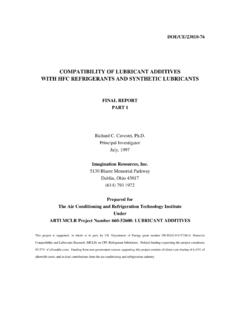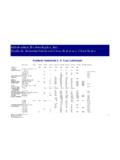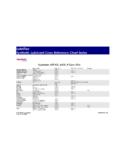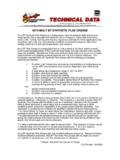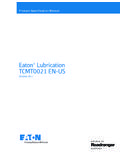Transcription of A Study of Automotive Gear Lubes - Last Great …
1 A Study of Automotive gear Lubes AMSOIL Drivetrain Division September 2007. AMSOIL INC. Overview The requirements for Automotive gear lubrication have changed over the years, yet vehicle owner awareness has not. gear lubrication has been commonly considered elementary, but, in fact, it is a dynamic process that requires sophisticated tech- nology. The differentials that house the gears are out of sight, out of mind. They are neglected. But differentials are just as important to the operation of a vehicle as the engine. An engine without a functioning differential will not move the vehicle.
2 gear lubrication needs to be taken more seriously than before. There are several forces driving the need for better gear lubrication. First, is improved fuel economy. Modern vehicle aerodynamics, with lower level air dams, is decreasing the air flow over dif- ferentials. Fuel economy is improved, but reduced air flow increases differential operating temperatures. Also, lubricant fill volumes in differentials have been reduced in order to lower fluid drag on the gears and bearings for further improvement in fuel economy. However, lubricants cool components, and with less fluid in the sump, operating temperatures rise.
3 Improvements in vehicle performance have created additional need for more sophisticated gear lubrication. Model-year 2007 turbo diesel pickup trucks, V-10 gasoline pickups and sport utility vehicles (SUVs), and high-horsepower V-8 trucks have more towing and payload capacities than in previous years, yet their differentials have not changed. There has been a 34% increase in engine horsepower over the last decade, while axle gear sizes have remained constant, sump capaci- ties have been lowered and drain intervals extended. In the light truck segment there has been a 93% horsepower increase since In vehicles such as a fifth-wheel equipped Ford F-350 Super Duty, towing capacities have reached a high of 19,200 And testing shows that in new axle applications simulating trailer towing at 88 km/h (55 mph) at a grade temperatures can reach as high as 188 C (370 F).
4 3 Stress on differentials has also increased in limousines, conversion vans, and trucks and cars with modified, high-performance engines. More power, more towing capacity and higher hauling limits greatly increase the stress that causes heat and wear. Improvements in vehicle comfort have also driven the need for better gear lubrication. The demand for greater interior space has forced vehicle manufacturers to lower floor boards, which restricts air flow to the differential. Hot exhaust systems are forced closer to the axle housing, and differential operating temperatures are increased even further.
5 Most vehicles operate under severe service as defined by vehicle manufacturers, but the majority of vehicle owners are unaware of this. Severe service applications include towing, hauling, plowing, off-road use, frequent stop-and-go driving, steep-hill driving and temperature extremes. Severe service applications are on the rise. For example, more than 90 per- cent of Ford Super Duty pickups are used for Severe service increases the need for better gear lubrication. Synthetic gear Lubes are recognized as superior to petroleum-based gear Lubes by vehicle manufacturers, gear manufac- turers and most high-performance Automotive experts.
6 Synthetic gear Lubes exhibit all-around better performance. There are many synthetic gear lubricants available to consumers, including those marketed by vehicle manufacturers. All position themselves as superior to the rest. Operating Conditions and Lubrication Requirements Differentials contain many different components, each having its own requirements for lubrication. The ring and pinion gears operate under extreme pressure and sliding contact that require extreme-pressure additives for protection. The bearings operate under rolling motion where lubricant film strength is particularly important, and limited-slip clutches require special friction additives for proper operation.
7 It is essential, therefore, that gear lube formulations be carefully balanced to protect all components. Too much emphasis on the needs of one component can detract from the needs of another. A Study of Automotive gear Lubes 2. The following illustration shows differential components: Reference 5. Purpose The purpose of this paper is to inform consumers about the increasingly severe conditions under which differentials oper- ate and to provide data reflecting the quality and cost differences of popular synthetic and petroleum gear Lubes . With this information, consumers are better prepared to make informed decisions when purchasing gear lubricants.
8 Method The testing by which the gear Lubes were evaluated was done in accordance with American Society for Testing and Materials (ASTM) procedures, Society of Automotive Engineers (SAE) J306 requirements and Federal Test Method Standards. Other than the oxidation filter patch procedure, performance testing was conducted by an independent labora- tory. Physical-property testing (viscosity, viscosity index, pour point and foaming after oxidation) was conducted in-house. A notarized affidavit certifying that the results are accurately reported is included in Appendix 1. gear lube pricing was obtained from the manufacturers or distributors, and a notarized affidavit certifying that those prices are reported as obtained is included in Appendix 2.
9 Scope The focus of this paper is on American Petroleum Institute (API) GL-5, SAE 75W-90 synthetic gear Lubes . Samples of API. GL-5, SAE 80W-90 petroleum gear Lubes were also included for comparative purposes. The tests were selected to meas- ure the properties consistent with extreme-pressure gear lubricant requirements and are intended to reveal the lubricants'. overall performance. The performance characteristics evaluated include each gear lube's ability to: 1. Meet the required viscosity grade of an application 2. Maintain viscosity when subjected to temperature changes 3.
10 Retain viscosity during use 4. Function in cold temperatures 5. Resist high temperatures and oxidation 6. Protect under extreme pressures 7. Protect against wear 8. Resist foaming 9. Prevent copper corrosion. 3 A Study of Automotive gear Lubes Review Candidates The cross-section of gear lubricants tested includes those offered by original equipment manufacturers (OEMs), motor oil companies and specialty companies. All gear Lubes , with the exception of Mopar Synthetic and Torco SGO Synthetic, are recommended by their manufacturers for limited-slip differentials and are therefore expected to contain appropriate limited- slip-type additives.
